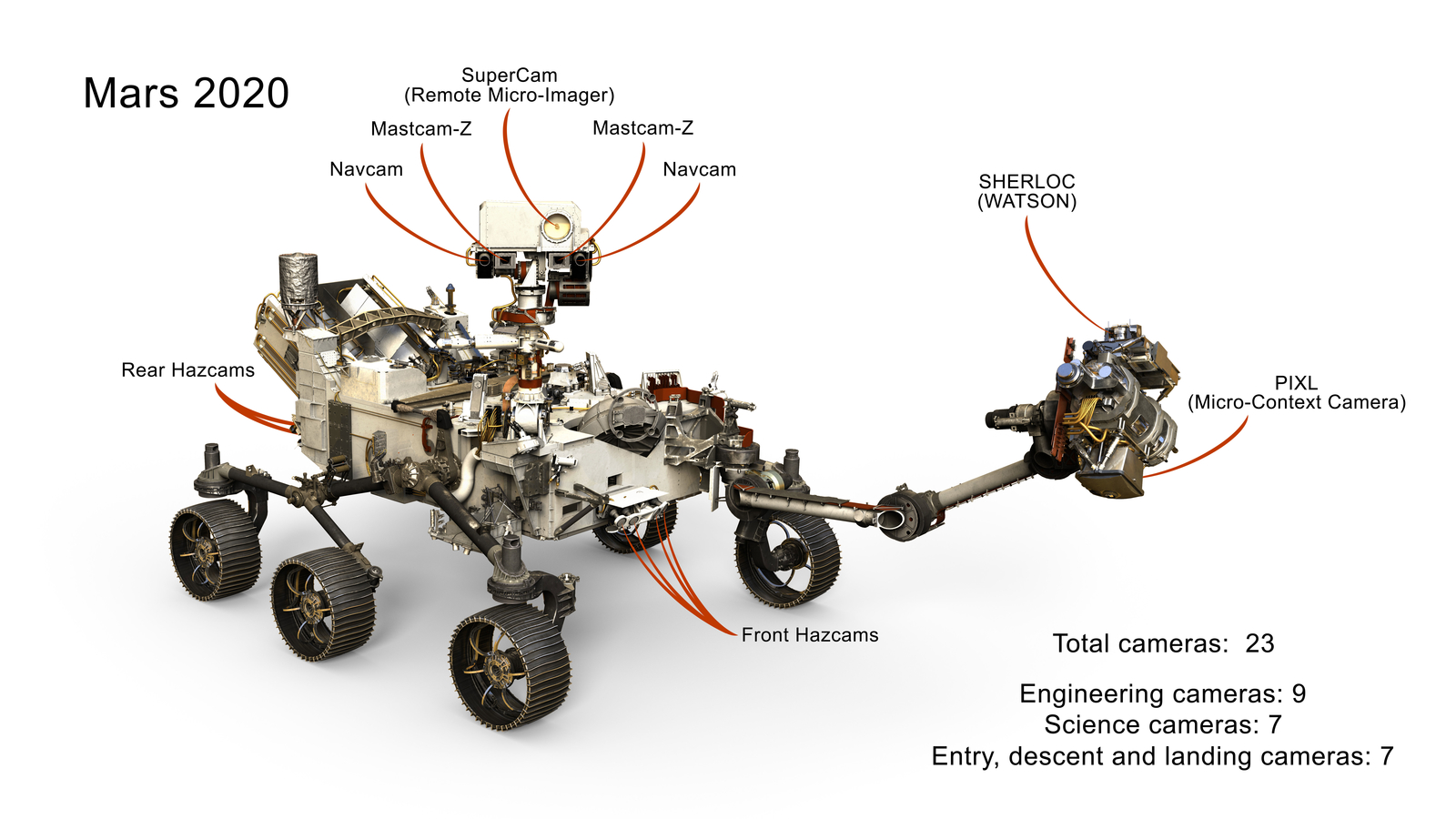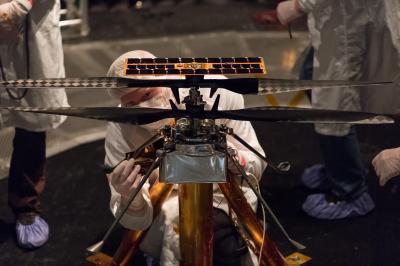While Mars may be significantly behind its sunward neighbor in terms of the number of motor vehicles crawling over its surface, it seems like we’re doing our best to close that gap. Over the last 23 years, humans have sent four successful rovers to the surface of the Red Planet, from the tiny Sojourner to the Volkswagen-sized Curiosity. These vehicles have all carved their six-wheeled tracks into the Martian dust, probing the soil and the atmosphere and taking pictures galore, all of which contribute mightily to our understanding of our (sometimes) nearest planetary neighbor.
You’d think then that sending still more rovers to Mars would yield diminishing returns, but it turns out there’s still plenty of science to do, especially if the dream of sending humans there to explore and perhaps live is to come true. And so the fleet of Martian rovers will be joined by two new vehicles over the next year or so, lead by the Mars 2020 program’s yet-to-be-named rover. Here’s a look at the next Martian buggy, and how it’s built for the job it’s intended to do.
If It Ain’t Broke…
The Mars 2020 mission is part of the broader Mars Exploration Program, or MEP. The MEP was born from the failure of the Mars Observer mission in 1992, NASA’s first attempted mission to Mars since the successful Viking program in the 1970s. The soil chemistry experiments performed by the static Viking landers suggested that life may have been possible on Mars, but the results were equivocal. NASA launched the MEP to answer the question of life on Mars definitively, as well as to characterize the geology and atmosphere of the planet to prepare for human exploration.
Unfortunately, a lot of the missions that were to make up MEP were lost to budget cutbacks in 2012, and the only money earmarked for planetary exploration was contingent of being spent on missions capable of returning samples to Earth. Curiosity had already made it to Mars by that point, though, and was returning exciting results and glorious photos of the Martian landscape. And while it was capable of sampling the Martian regolith, Curiosity was not able to collect samples that could one day be returned to Earth.
Curiosity did, however, prove that a large rover with a complex mission profile could land successfully and perform under challenging conditions. Not willing to mess with success, and operating under budget restrictions, NASA decided to essentially clone Curiosity for the Mars 2020 rover. The rovers would be mechanically very similar, with different science packages bolted on, as well as the addition of the hardware needed to package samples for eventual retrieval and return to Earth.
Super-Charged for Science
Outwardly, it’s hard to tell the difference between Curiosity and the Mars 2020 rover. Both use the proven six-wheel articulated bogie design, with each wheel powered by its own electric motor. The wheels have been redesigned for Mars 2020, though, thanks to lessons learned from seven years of abuse suffered by Curiosity‘s wheels.

The main hulls of the two rovers look almost identical, with the same angled “trunk” area at the rear of the vehicle supporting the same plutonium-powered Multi-Mission Radioisotope Thermal Generator (MMRTG) module to provide 110 Watts of electrical power and 2,000 Watts of heat for the rovers’ guts. The Mars 2020 MMRTG is literally a leftover from Curiosity, as are many other parts and instruments.
Things start to differ when you start looking at the science the two rovers were designed to support. The most obvious difference is the main robotic arm of Mars 2020, which is stronger than the arm on Curiosity and sports different instruments, such as an X-ray fluorescence spectrometer dubbed PIXL and a pair of adorably named geological instruments: SHERLOC, an ultraviolet Raman spectrometer for fine-scale mineralogy and detection of organic molecules, and WATSON, a high-resolution camera to provide images of targets that SHERLOC might be interested in.
The Mars 2020 rover arm also supports a coring drill, designed to cut cylindrical core sections from rock rather than just pulverize them as Curiosity‘s drill does. A “bit carousel” allows the arm to select from a number of other tools, including grinding tools to abrade rocks.
Return to Sender
Should a particular sample prove promising based on the results of on-board experiments, a sample handling system in the belly of the rover will get to work. The bit carousel has slots to accept special sample containers, which are stored in a rack under the rover. A small robotic arm, looking somewhat like a SCARA arm from a semiconductor fab, places a sample tube in the bit carousel, which rotates it up so the arm can access it. The core sample is ejected into the sample tube, which is then returned to storage in the sample handling area before being hermetically sealed. The sample handling hardware is shown nicely in the video below:
The rover can collect and store up to 43 samples on-board. The mission plan calls for the team to designate a “caching depot” where the samples collected during the one Martian year-long primary mission will be dropped. Sample tubes, along with control tubes to assess unintended contamination, will be released from the sample handler into a pile on the regolith. Any samples collected during the subsequent extended mission will also be left at the cache, to await a future sample return mission.
The Mars 2020 rover’s landing site, Jezero Crater, was selected because it was once a 250 meter deep lake at about the time life was first appearing on Earth. On Earth, the sediments that are deposited into lake beds are rich in life, and it’s hoped that Martian sediments have preserved any signs of life that developed 3.5 billion years ago. Also, the ancient lake bed features a delta structure from a river that once fed into it, again holding potential for finding “biosignatures” from any life that got a toehold on Mars.
Droning On

One of the most interesting pieces of hardware making the trip aboard the rover is the Mars Helicopter Scout. Primarily included to test the technology and explore the challenges of extraterrestrial aviation, the small drone will make several short flights sometime in the early part of the rover’s primary mission. Stored in the rover’s belly, the coaxial-rotor drone carries an array of technology that will seem familiar to most hackers: a Snapdragon SoC running Linux, MCUs for flight control, and a Zig-Bee link back to the rover. It even has a lithium-ion battery pack and camera for navigation and observation.
Each of the MHS flights will last only about 3 minutes and get no more than 10 meters above the surface. Navigation will use a solar tracker and inertial guidance. NASA hopes that the high-resolution camera will provide detailed images of the sample cache to inform the design of sample return mission hardware.
Between the first extraterrestrial aircraft, the slate of science experiments planned – including making oxygen from the thin Martian atmosphere – and the potential to actually return pieces of the Martian regolith, Mars 2020 has the potential to be a breakthrough mission. And with the rover safely bundled up and being prepared for integration with the launch vehicle, everything seems on-track for the mission’s July launch, and the rover’s date with destiny.
[Featured images: NASA/JPL]
No comments:
Post a Comment